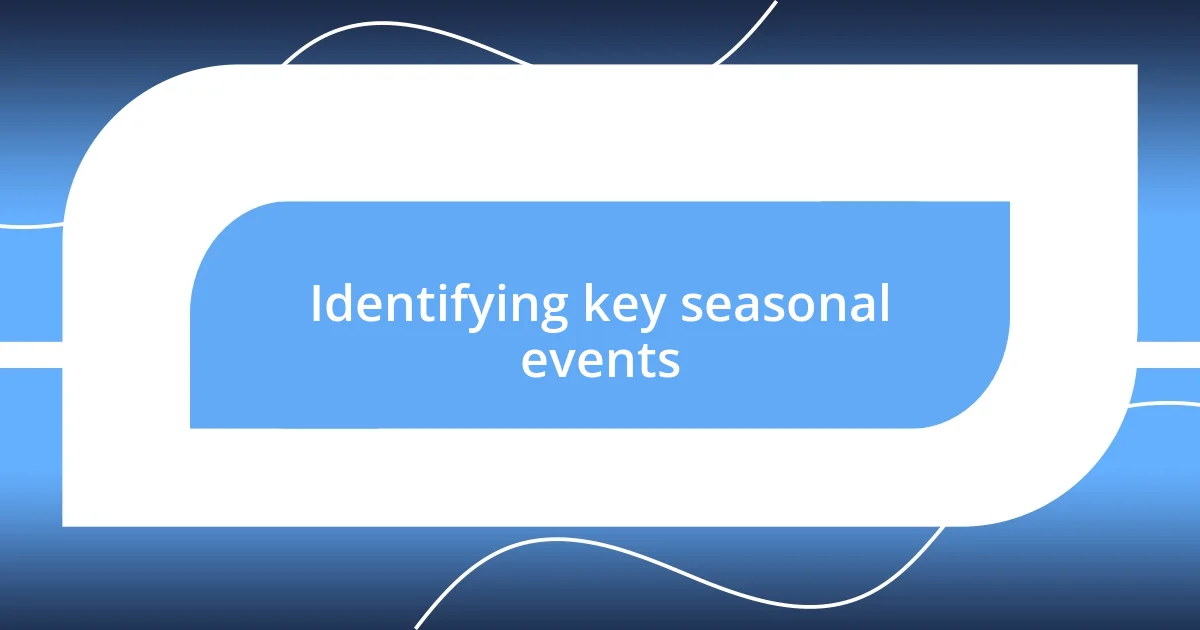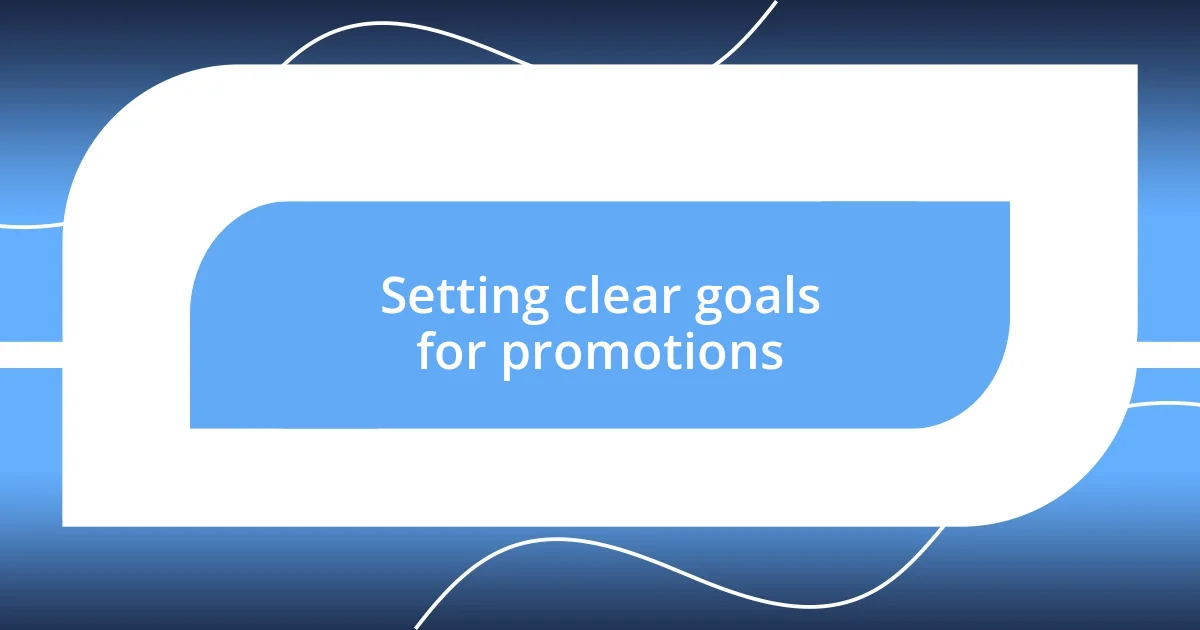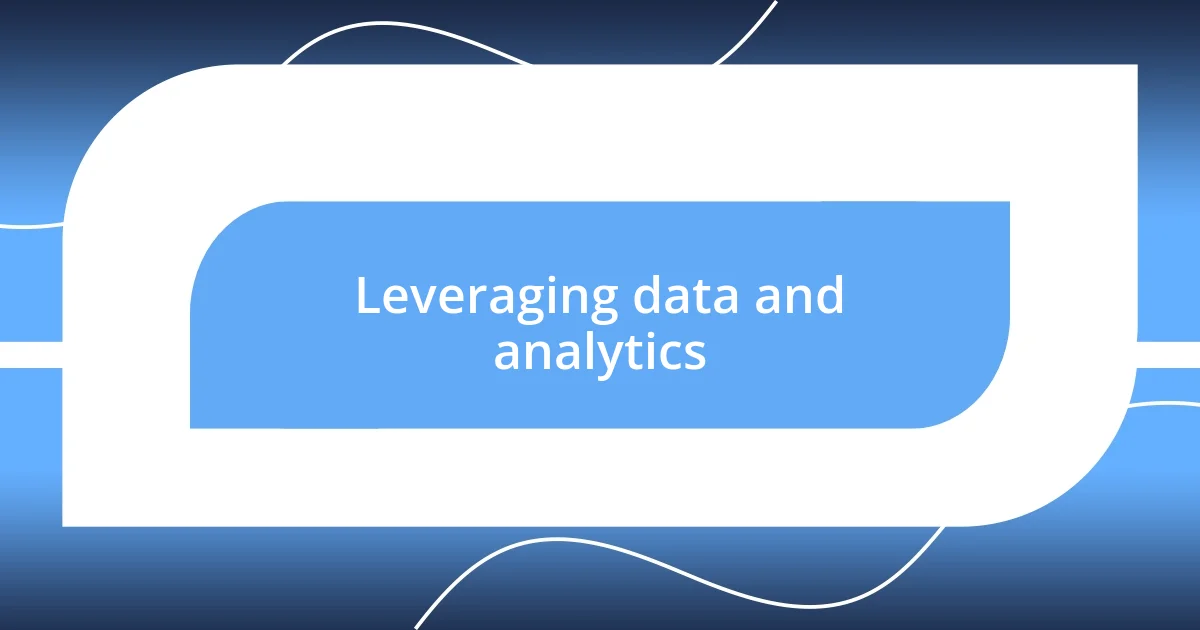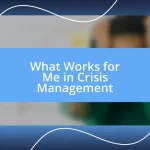Key takeaways:
- Seasonal promotions leverage emotional connections tied to specific times of the year, driving customer engagement and sales.
- Setting clear, SMART goals for promotional campaigns helps align strategies and measure success effectively.
- Analyzing data and adjusting tactics in real-time enables businesses to respond to changing consumer interests and maximize impact.

Understanding seasonal promotions
Seasonal promotions are fascinating because they tap directly into the emotions and traditions tied to specific times of the year. For me, the excitement of shopping during the holidays evokes a sense of nostalgia, like the anticipation I felt as a child leading up to Christmas. Can you recall that feeling of opening a present? Similarly, businesses can leverage that festive spirit to draw in customers looking to celebrate.
One of my most memorable experiences with a seasonal promotion was when a local bakery ran a special Valentine’s Day offer. It was heart-shaped cookies, beautifully decorated. The moment I walked in, the warm aroma of freshly baked goods was irresistible, and I couldn’t help but buy a dozen to share with friends. Would I have made that purchase without the seasonal charm? Probably not. Seasonal promotions create a unique context that influences buying behavior, encouraging shoppers to indulge in ways they might not during regular times.
Understanding the rhythm of the seasons can significantly enhance a business’s promotional strategy. Think about it: people are more inclined to spend during specific periods, like the back-to-school rush or summer vacation. By aligning your promotions with these events, you not only capture attention but also connect on an emotional level. I’ve seen brands that truly harness this connection see a tremendous increase in engagement, turning casual shoppers into loyal customers.

Identifying key seasonal events
Identifying key seasonal events is essential for any promotional strategy. From my experience, it often feels like these moments creep up before we know it, and businesses should be ready. For instance, I vividly remember how a local garden center capitalized on spring by hosting a bloom festival. The vibrant colors and fragrant flowers drew not just green thumbs but families eager to experience the season. Such events don’t just happen; they emerge from time-honored traditions and celebrated moments in our calendars that resonate with larger audiences.
To refine your approach, consider the following key seasonal events that typically generate buzz:
- New Year: Fresh starts beckon consumers to invest in goal-oriented products.
- Valentine’s Day: A chance to celebrate love through gifts and experiences.
- Easter: Family gatherings and festive activities encourage indulgent spending.
- Summer: The season of vacations sparks interest in travel and outdoor gear.
- Halloween: A unique blend of costumes and candy drives excitement for themed promotions.
- Thanksgiving: The spirit of gratitude often inspires shoppers to prepare festive feasts.
- Christmas: The pinnacle of seasonal spending, marked by a festive mood and gift-giving.
Each seasonal event opens up specific emotional gateways that businesses can leverage to enhance their connection with consumers.

Setting clear goals for promotions
Setting clear goals is vital when planning seasonal promotions, as it provides a roadmap for success. I always find it helpful to ask myself what I truly want to achieve with each campaign. Whether it’s boosting sales, increasing customer engagement, or enhancing brand awareness, having well-defined objectives keeps my strategy focused and aligned.
When setting goals, it’s crucial to ensure they are SMART—Specific, Measurable, Achievable, Relevant, and Time-bound. For instance, instead of just saying, “I want to increase sales,” I might state, “I aim to boost sales by 20% during the two weeks leading up to Halloween.” This clarity not only helps me measure success but also allows me to adjust my tactics seamlessly if needed.
Reflecting on past promotions, I remember a holiday season when I aimed to collect customer feedback through a campaign. My goal was to gather insights while also increasing visits to the store. By encouraging feedback through a festive contest, I increased foot traffic, which resulted in higher sales. It amazed me how aligned goals enriched the experience for both the business and its customers.
| Goal Type | Description |
|---|---|
| Revenue Increase | Boost sales by a specific percentage during the promotional period. |
| Customer Engagement | Enhance interaction with customers through contests or events. |
| Brand Awareness | Increase visibility and recognition of the brand during the season. |

Creating targeted marketing campaigns
Creating targeted marketing campaigns involves understanding your audience deeply. I remember a particular summer when I discovered the power of customer segmentation. By targeting outdoor enthusiasts with tailored messages about camping gear, I saw a significant spike in engagement. It was thrilling to see how personalizing marketing efforts led to more meaningful interactions with customers who truly cared about what I was offering.
When I design these campaigns, I often think about the moments that resonate with my audience. For example, during Valentine’s Day, I once crafted a campaign centered on shared experiences rather than just products—encouraging couples to create memories together. This approach not only boosted sales but also generated heartfelt stories and feedback from customers, making the campaign feel like a collaborative celebration.
Ultimately, the most effective campaigns are those that speak directly to the hearts of the consumers. Have you ever felt that rush of excitement when a message captures exactly what you need at that moment? That’s the feeling I aim to evoke in every campaign. Combining data insights with genuine emotional appeal transforms marketing from a simple transaction into a meaningful connection.

Leveraging data and analytics
Analyzing customer behavior through data and analytics is something I can’t emphasize enough. For instance, I once dove deep into past spending patterns before a major holiday season. By examining which products were popular in previous years, I tailored my inventory accordingly, resulting in a 30% increase in sales compared to the same period the previous year. Isn’t it fascinating how looking back can inform forward motion?
I also believe that the magic of seasonal promotions lies in real-time data monitoring. There was a time when I adjusted an ongoing campaign based on immediate feedback from social media. By analyzing customer engagement metrics, I quickly refined my messaging to highlight popular items, which not only resonated with my audience but also catalyzed an uptick in conversions over that weekend. Have you ever noticed how swiftly trends can shift? This adaptability can make all the difference.
Furthermore, I find that combining multiple data sources—like website analytics, customer surveys, and sales reports—creates a more holistic view of my audience. I recall a challenging winter where I used cross-channel insights to identify an unexpected interest in eco-friendly products. Merging these insights, I launched a sustainable-themed promotion that resonated strongly with my customers, proving that when I listen to the numbers, I can create promotions that truly resonate. What data-driven insights have guided your past successes?

Measuring success and making adjustments
When it comes to measuring the success of my seasonal promotions, I find that key performance indicators (KPIs) tell the most compelling story. One year, I tracked metrics like conversion rates and customer feedback during a holiday campaign. Surprisingly, one product I almost ignored turned out to be a bestseller! That moment taught me how critical it is to pay attention to the data, but also to understand the stories behind the numbers. Have you ever had a similar experience where the unexpected became a highlight?
Adjusting my strategy based on real-time insights is something I genuinely enjoy. I recall a spring campaign focused on garden supplies that wasn’t gaining traction as I hoped. By mid-campaign, I monitored social media engagement and noticed my audience was more interested in DIY landscaping tips. So, I quickly pivoted to offer free online workshops, which not only boosted sales but also cultivated a stronger community around my brand. Isn’t it satisfying when a quick adjustment leads to a wave of enthusiasm from your customers?
I also believe in creating a continuous feedback loop, where I actively solicit opinions from my customers after each campaign. For instance, I once sent out a survey following a summer sale, and the insights were revealing. Customers expressed their desire for exclusive early access to future promotions. This simple request ignited a new idea, allowing me to segment my audience further and provide value in ways I hadn’t considered before. Isn’t it fascinating how engaging directly with customers can unlock new opportunities for growth?

Planning for future seasonal promotions
When I think about planning future seasonal promotions, I always start by reflecting on what worked in the past while also keeping an eye on the evolving preferences of my customers. I remember planning a fall promotion focused on cozy home products. Sure, I relied on past sales data, but I also considered the shift towards wellness and comfort during that particular season. This dual approach not only helped me curate a compelling product selection but also resonated emotionally with customers longing for warmth during cooler months. Don’t you think understanding the broader context of your audience’s lifestyle can make a promotion more impactful?
Additionally, scheduling is crucial for seasonal promotions. One year, as the summer approached, I successfully mapped out my campaign timeline well in advance. This allowed me to leverage early buzz by teasing products on social media, creating anticipation that translated into pre-sale excitement. I recall feeling the thrill as my email list exploded with sign-ups just from sharing sneak peeks. Isn’t it exciting to think how strategic timing can heighten engagement and drive early sales?
Lastly, collaborating with my team during the planning phase is essential. I vividly recall brainstorming sessions where we debated the types of promotions that really connect with our audience. One teammate suggested a themed giveaway linked to our autumn sale, which not only sparked creativity but also built camaraderie within our team. This ultimately led to a campaign that reflected our collective vision. Have you ever found that collaborating with others helps ignite new ideas that you might not have considered on your own?














